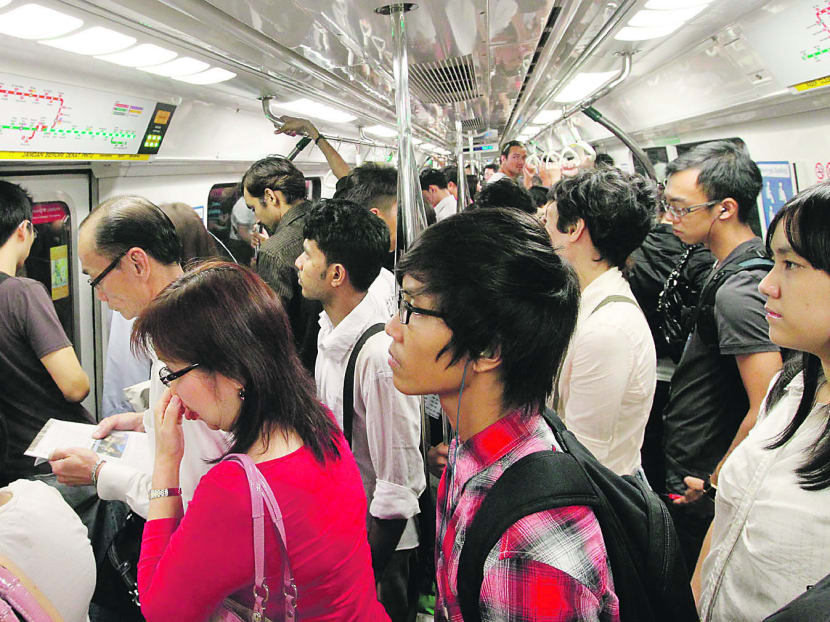Updated transport master plan as more take to buses, trains
SINGAPORE — After hitting a speed bump, the Government’s push to get more people onto buses and trains is back on course. Public transport’s share of the total number of trips made during the peak period rose to 63 per cent last year, reversing a downward trend that first began when the Household Interview Travel Survey was first conducted in 1997.
SINGAPORE — After hitting a speed bump, the Government’s push to get more people onto buses and trains is back on course. Public transport’s share of the total number of trips made during the peak period rose to 63 per cent last year, reversing a downward trend that first began when the Household Interview Travel Survey was first conducted in 1997.
The growth was fuelled largely by the expansion of the rail network over the last four years, with the number of train trips rising by 35 per cent to 2.3 million daily trips last year.
Citing these findings yesterday, Transport Minister Lui Tuck Yew said the Government’s “major policy decision” five years ago to make public transport a choice mode has “made good progress”.
Singapore, like all other growing cities in the world, will have to do more to curb the reliance on private cars, he added. “But doing more of the same is not enough. We have to decisively push for a strategic mode shift from private to public transport,” Mr Lui said, as he launched a refreshed Land Transport Master Plan at the inaugural Singapore International Transport Congress and Exhibition.
The master plan was first launched in 2008 and came at a time when public transport use declined over the decade. Travel on public transport was 67 per cent of the total number of trips made in 1997. In 2004, it fell to 63 per cent and in 2008, it shrank to 59 per cent.
The new master plan laid out four priorities: More connections, better service, a liveable and inclusive society, and reducing reliance on private transport.
By 2030, Singapore’s rail network will be 360km — double what it is currently and higher than in Tokyo or Hong Kong — and its rail density will be comparable to London.
Recognising “a multiplier effect” in having a denser and more connected rail network, which makes taking trains more attractive for motorists to switch to public transport, Mr Lui yesterday announced that the first six stations of the Downtown Line will open on Dec 22.
The stations —Bugis, Promenade, Bayfront, Downtown, Telok Ayer and Chinatown — will connect to existing rail lines to enhance connectivity in the city. To achieve better service, the Land Transport Authority (LTA) will, among other moves, set new requirements for trains to arrive at shorter frequencies during the 30-minute time slots before and after the morning and evening peak periods. It is also studying if information on bus crowding could be provided to commuters so that they can make more informed choices for their journeys.
While all train stations and bus interchanges have been made accessible to the less mobile, the LTA will do even more, such as implementing audio-tactile systems at more traffic junctions to aid the visually-impaired.
Speaking to reporters on the sidelines of the conference, Mr Lui said he was confident of increasing public transport modal share to 70 per cent by the end of this decade, as the rail network is expanding “significantly”. Under the master plan, eight in 10 households will live within a 10-minute walk from a train station.
Transport analysts agreed this would be an achievable target. Associate Professor Lee Der Horng, a transport researcher at the National University of Singapore, felt that the new train lines and the high cost of car ownership could push more towards public transport.
“Despite the comfort a car brings, even non-drivers and non-car owners are thinking twice and saying it’s too expensive,” he said.
According to the survey, individuals with monthly incomes higher than S$8,000 who took public transport rose to 28 per cent last year, up from 23 per cent in 2008.
Asked about the impact of surging Certificate of Entitlement premiums on shifting motorists towards public transport, Mr Lui noted that close to one in two households own a car — a situation unsustainable in the future. Roads comprised 12 per cent of total land area here, compared to 14 per cent for housing.
“Going forward, we must make sure that the possibility of people switching away from cars to public transport is there, and the way to do it is to make sure that the connectivity, the connections, the quality of service is much better than it is today,” Mr Lui said.







